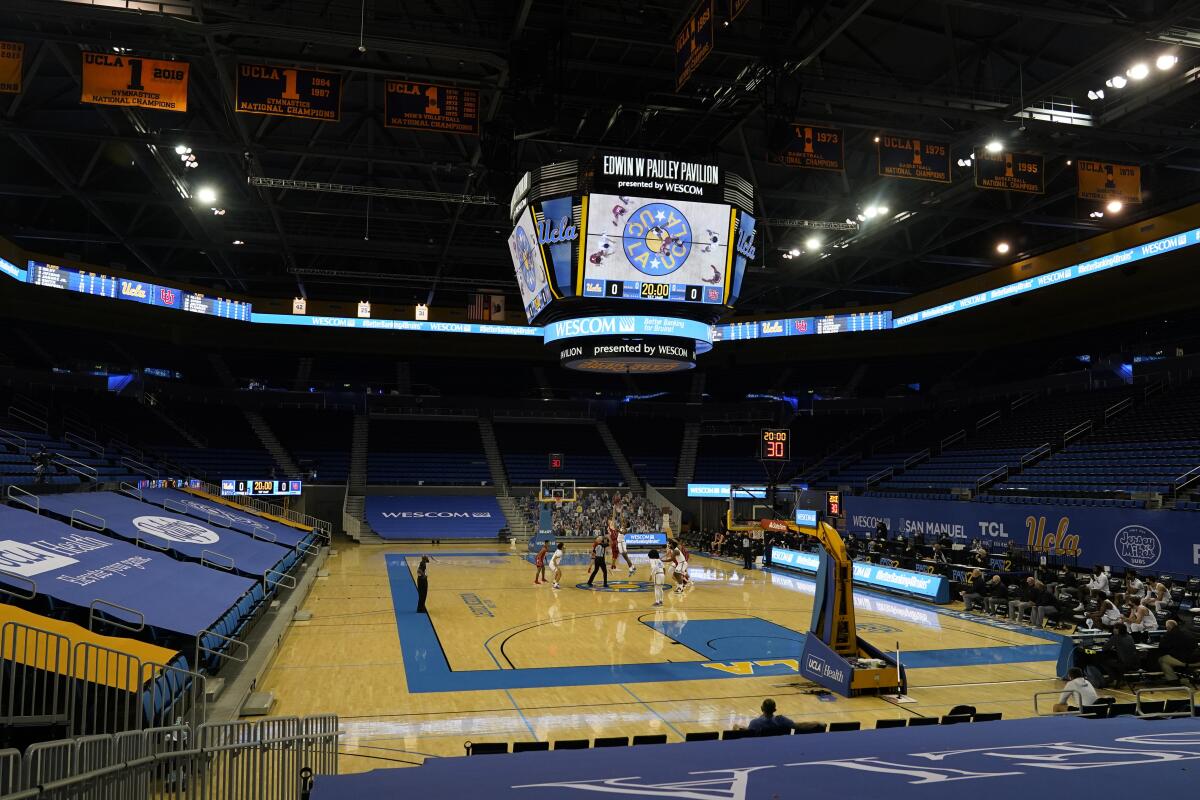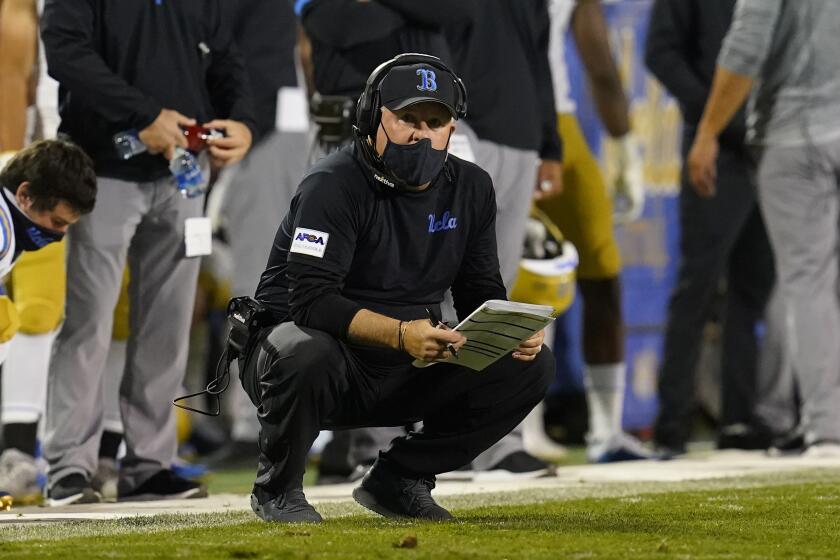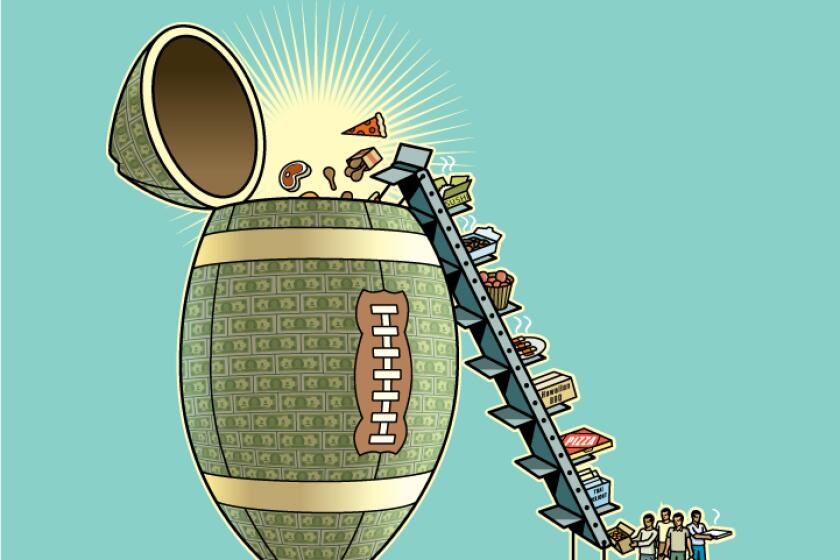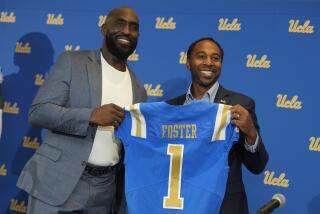UCLA’s athletic department posts $21.7-million deficit for 2020 fiscal year

- Share via
UCLA’s athletic department, having doubled down on debt in the wake of a record shortfall, is facing a far bigger money crunch.
The Bruins’ $21.7-million deficit for the 2020 fiscal year, which brought their two-year deficit to $40.6 million, might seem like pocket change compared with how much deeper they are poised to plunge into the red.
The dual punch of COVID-19 and a fractious divorce from Under Armour will wallop a 2021 budget that could drastically exacerbate the deficit, leaving the department in need of a sustained turnaround sparked by football and basketball success driving ticket sales and donations to help close the gap in future years.
“This past year was a challenging one financially in all of collegiate athletics, with UCLA athletics being no exception,” said a statement provided by an athletic department spokesperson. “The pandemic’s impact will be felt throughout the coming years, but we are committed to reaching long-term fiscal stability for our athletic program. We will continue to provide our student-athletes a championship experience on and off the field and build on our rich history of developing them for success in sports and in life.”
The deficits from each of the last two years, including an $18.9-million shortfall in 2019, will be covered by an interest-bearing loan from the university, according to a person close to the situation not authorized to comment publicly because of the private nature of the arrangement. New UCLA athletic director Martin Jarmond declined to comment on the 2020 budget shortfall because he started July 1, the beginning of the 2021 fiscal year.
Third-year coach Chip Kelly has compiled a 7-18 record through the opening week of his third season, meaning that each win has cost UCLA roughly $1.59 million.
The Bruins appear to have weathered their budget crunch better than many other schools, not slashing athletic department personnel or cutting sports programs. Stanford eliminated 11 sports as a result of financial difficulties associated with the pandemic.
But UCLA’s financial hole is especially deep given its history. The Bruins had previously enjoyed a long stretch of operating in the black before 2019, their last shortfall coming in 2004 when they were only $164,000 in the red.
The Bruins’ 2020 deficit was predictable and tied to a variety of factors, including another significant drop in football ticket revenue after the team went 4-8 and did not play USC at home. UCLA averaged 43,849 fans and 25,136 season ticket-holders at the Rose Bowl in 2019, record lows that generated $9.2 million in revenue. That’s a decline of $3.3 million from the previous season and less than half of the $20 million the team brought in while setting attendance records in 2014.
UCLA’s men’s basketball attendance also sagged to a record-low average of 6,706 inside Pauley Pavilion for the 2019-2020 season before spiking amid a late-season surge, the Bruins drawing 11,567 for their final home game against Arizona. But the team’s $4.9 million in ticket revenue was down from $5.7 million the previous year.
There was another drop in revenue because athletic departments across the country received $225 million from the canceled NCAA men’s basketball tournament instead of the usual $600 million. UCLA received $2 million less from the NCAA than it had been given the previous year.
As the centerpiece of a department facing a growing deficit, UCLA football has gorged itself on food spending that has no rival nationwide.
Other factors that contributed to UCLA’s deficit were $2 million in annual maintenance costs associated with the Wasserman Football Center and Mo Ostin Basketball Center; roughly $1 million for chartered flights for the men’s and women’s basketball teams; and increased financial resources funneled toward Olympic sports teams.
UCLA’s football players were fed slightly less lavishly during coach Chip Kelly’s second season, consuming $3.5 million in meals during the 2020 fiscal year after their meals totaled $5.4 million the previous fiscal year. The team found some efficiencies that allowed the price per meal to drop while providing the same quality ingredients, according to one person close to the situation. Fewer meals were also provided as a result of spring practice lasting only one week.
Revenue sharing from the Pac-12 Networks that netted UCLA $2.9 million continued to fall well below original long-term projections, and the conference’s national television rights deals run through the spring of 2024, meaning there is no possibility of a short-term financial windfall.
UCLA is also constrained by generating only a small percentage of its athletic department budget from campus sources. The Bruins receive $60,000 a year from the school in addition to about $2.5 million in student fees, a total that’s less than half of the $5.2-million average in institutional support distributed by the Pac-12’s other public schools.
Former UCLA gymnast Rachel Luba is the sports agent for reigning pitcher Trevor Bauer, who signed a three-year, $102-million deal with the Dodgers.
UCLA faces a much bigger budget crisis in 2021. Under Armour informed the school in late June that it intended to sever the record 15-year, $280-million contract the sides had agreed to in 2016, wiping out roughly $11 million per year in rights and marketing fees.
The Bruins’ new apparel deal with Jordan Brand and Nike is believed to be far less financially lucrative than the one they had with Under Armour, though the terms of the contract have not been made public. UCLA hopes to recoup at least part of the money it was owed from Under Armour through a lawsuit in which it has sued the apparel giant for more than $200 million.
There’s nothing the Bruins can do about truncated football and basketball seasons in which they were prohibited from hosting fans at the Rose Bowl and Pauley Pavilion.
For the Bruins to get back into the black, their flagship teams will have to win more games and draw bigger crowds. Presuming, of course, that the pandemic will subside and crowds will be permitted.
UCLA revenue/expense summary for 2020 fiscal year.
More to Read
Go beyond the scoreboard
Get the latest on L.A.'s teams in the daily Sports Report newsletter.
You may occasionally receive promotional content from the Los Angeles Times.









